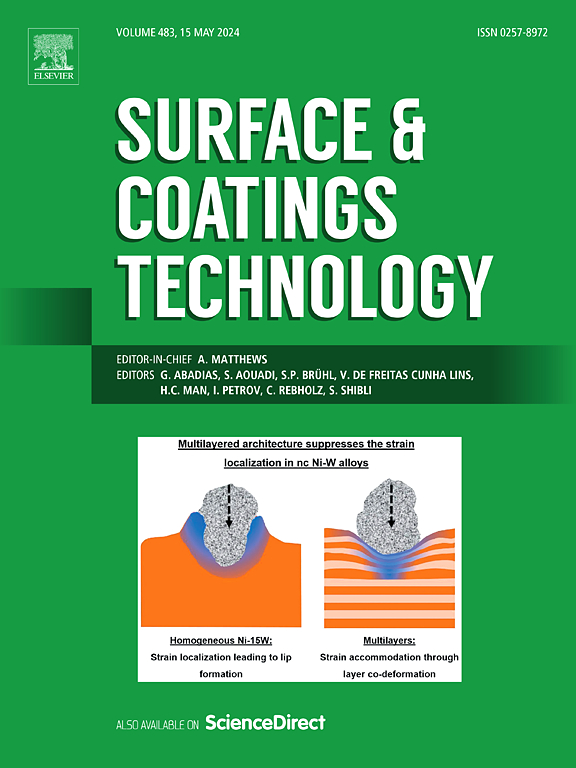超高灵敏度大动态范围光学游标生物传感器用磁控溅射金属-介电-金属(MDM)多层膜的椭偏特性研究
IF 5.3
2区 材料科学
Q1 MATERIALS SCIENCE, COATINGS & FILMS
引用次数: 0
摘要
我们系统地研究了一种混合等离子体-光子光学游标(OVS)生物传感器的光学特性,该传感器采用多个零反射点(zrp),具有~10−8折射率单位(RIU)的超低检测限(LoD)和~6个数量级的RIU传感动态范围。p-极化和s-极化zrp的协同协作产生了OVS操作模式,该模式基于传感介质折射率变化的动态拟合,可以对生物分子相互作用事件进行精确的光学量化。该光学模型根据生物传感器的结构和本构银(Ag)和氮化铝(AlN)层在320 ~ 1690 nm光谱范围内的参数化色散特性,以及在传感器功能化和运行过程中实时跟踪动态RIU变化的能力,对生物传感器的运行进行了定量描述。在室温下,采用反应磁控溅射法将Al靶材在不同Ar/N2气体比下沉积在玻璃衬底上。利用椭偏光谱法研究了AlN薄膜的光学常数、厚度和表面粗糙度。结果表明,反应气体流量比可以控制AlN薄膜的光学性能。当反应气体比从30%调节到70%时,AlN薄膜在633 nm波长处的折射率(n)在1.75 ~ 1.84之间变化,消光系数(k)在233 nm波长处的消光系数(k)在0.005 ~ 0.05之间变化,带隙Eg(消光系数k <;0.001,在0和5.03 eV之间变化。最后,研究了AlN膜在金属-介电介质-金属(MDM)多层材料中的应用,通过全内反射椭偏测量显示出独特的光谱特征,并将其用于兔IgG的生物检测,LoD低于10 ng/mL。我们的拟合方法的稳定性和可靠性,加上MDM多层结构优异的灵敏度,使该系统在生物传感领域具有很强的竞争力。本文章由计算机程序翻译,如有差异,请以英文原文为准。
Ellipsometric characterization of magnetron sputtered metal-dielectric-metal (MDM) multilayers for Optical Vernier Scale biosensors with ultra-high sensitivity and large dynamic range
We provide a systematic investigation of the optical properties of a hybrid plasmonic–photonic Optical Vernier Scale (OVS) biosensor using multiple zero-reflection points (ZRPs) with ultra-low limit of detection (LoD) of ~10−8 refractive index unit (RIU) and large dynamic range of ~6 orders of magnitude in RIU sensing. The synergic collaboration of p- and s-polarized ZRPs results in the OVS operation mode that enables precise optical quantification of biomolecular interaction events based on the dynamic fitting of the sensing medium's refractive index changes. The optical model provides a quantitative description of the biosensor operation in terms of its structure and the parameterized dispersion properties of the constitutive silver (Ag) and aluminum nitride (AlN) layers, in the spectral range from 320 to 1690 nm, as well as the ability to follow the dynamic RIU changes in real-time during sensor functionalization and operation. The AlN thin films were first deposited on glass substrates by reactive magnetron sputtering from Al target under different Ar/N2 gas ratios at room temperature. The optical constants, thickness, and surface roughness of the AlN thin films were then investigated using spectroscopic ellipsometry. It was found that the reactive gas flow ratio can control the optical properties of the AlN films. When the reactive gas ratio was adjusted from 30 % to 70 %, the refractive index (n) of the AlN thin films varied from 1.75 to 1.84 at a wavelength of 633 nm, the extinction coefficient (k) of the AlN samples varied from 0.005 to 0.05 at a wavelength of 233 nm, and the band gap , defined where the extinction coefficient k < 0.001, varies between 0 and 5.03 eV. Finally, the application of the AlN film in a metal-dielectric-metal (MDM) multilayer was investigated, showing unique spectral characteristics by total internal reflection ellipsometry measurements and used for the bio-detection of rabbit IgG with a LoD below 10 ng/mL. The demonstrated stability and reliability of our fitting method, coupled with the excellent sensitivity of the MDM multilayer structure, make this system highly competitive in the field of biosensing.
求助全文
通过发布文献求助,成功后即可免费获取论文全文。
去求助
来源期刊

Surface & Coatings Technology
工程技术-材料科学:膜
CiteScore
10.00
自引率
11.10%
发文量
921
审稿时长
19 days
期刊介绍:
Surface and Coatings Technology is an international archival journal publishing scientific papers on significant developments in surface and interface engineering to modify and improve the surface properties of materials for protection in demanding contact conditions or aggressive environments, or for enhanced functional performance. Contributions range from original scientific articles concerned with fundamental and applied aspects of research or direct applications of metallic, inorganic, organic and composite coatings, to invited reviews of current technology in specific areas. Papers submitted to this journal are expected to be in line with the following aspects in processes, and properties/performance:
A. Processes: Physical and chemical vapour deposition techniques, thermal and plasma spraying, surface modification by directed energy techniques such as ion, electron and laser beams, thermo-chemical treatment, wet chemical and electrochemical processes such as plating, sol-gel coating, anodization, plasma electrolytic oxidation, etc., but excluding painting.
B. Properties/performance: friction performance, wear resistance (e.g., abrasion, erosion, fretting, etc), corrosion and oxidation resistance, thermal protection, diffusion resistance, hydrophilicity/hydrophobicity, and properties relevant to smart materials behaviour and enhanced multifunctional performance for environmental, energy and medical applications, but excluding device aspects.
 求助内容:
求助内容: 应助结果提醒方式:
应助结果提醒方式:


